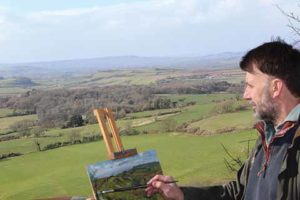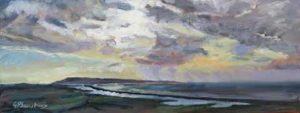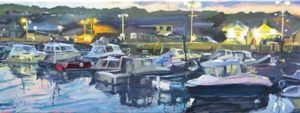West Dorset inspiration
Tim Saunders on why West Dorset, and the Bride Valley in particular, is so inspirational to Long Bredy oil painter George Paul Sainsbury.
Published in June ’18
The commute is not an unfamiliar concept to George Paul Sainsbury: all his favourite places are within ten minutes of his front door. ‘I am drawn to the golden cliffs of Hive Beach (east of Burton Bradstock), the great waves and the view of Lyme in the distance,’ he says. ‘Abbotsbury Castle with its iconic views across Abbotsbury and the Fleet to Portland or looking west across Lyme Bay to Golden Cap are inspirational, as is Eggardon Hill and the road down towards the Spyway Inn and the sea.’ West Bay regularly features in Paul’s paintings as ‘it provides a lively mix of working fishing harbour, marina, chips and ice cream.’ Charmouth beach also appeals for the reflections off the dark wet sand at low tide.
‘In Dorset,’ says Paul, ‘thanks to the east to west limestone ridges, there are wonderful cliffs, coves and seascapes. Within a very short distance inland over the protecting ridge there are soft green valleys providing long framed views. He feels extremely lucky to live in Long Bredy: ‘Because the Bride Valley is not traversed by any main thoroughfare, it has remained an almost secret valley with its small winding river starting at the Valley of Stones, past Bridehead House, bubbling through fields of Longhorn cattle before stumbling into the sea by Burton Bradstock at Freshwater Bay.’
This year, having painted several views in the valley, he is starting a project to sketch and paint his way down through the Bride Valley, from source to sea. These paintings will feature in ‘Dorset: Landscapes, Flora and Fauna’, an exhibition at Bridport Arts Centre from 3 July to 4 August. When on site, he creates small oil sketches on gesso-coated boards. Sometimes these are almost finished and successful as paintings in their own right, ‘but occasionally they need to be quick, rushed statements as a note to record my initial response to the light and atmosphere. If a larger painting, many such sketches may be made on several visits.’
In the studio Paul uses these studies, coupled with the experience of having been there, to produce his final painting. Working outside en plein air gives Paul an exciting rush ‘because it is such a challenge to paint during all kinds of weather. A sense of place only comes from the familiarity gained from time spent out in a location recording visual information and experiencing the place in the light and weather in a moment.’ When the weather wears Paul down, he will paint a small still life, concentrating on the careful observation of reflections on the glass and water of a jar of flowers. His overriding preference is to paint the sky: ‘I like painting big, complex skies, being motivated and inspired by the light just before or after storms or showers and at dawn and sunset.’
On the wall in Paul’s studio there is a quote from French painter Edgar Degas, which concentrates Paul’s mind: ‘A painting requires a little mystery, some vagueness and some fantasy. When you always make your meaning perfectly plain you end up boring people.’ He also respects J M W Turner, who painted to show what a particular scene looked like. Paul’s aim is not to produce ‘a soulless photographic reproduction’.
Born in Oldham to a surveyor father and a pharmacist mother, Paul grew up in Lancashire on the edge of the moors surrounded by sheep. His first experience of Dorset was spending a week here during his Geology A-level: ‘We walked the Jurassic coast from Beer to Swanage. I stayed at the youth hostel in Litton Cheney, a mile from where I live now.’ A ‘fantastic art teacher’, Roger Hardaker, a ceramicist with whom Paul shared an interest in fly fishing, got him involved in life drawing and ceramics at the local art college in Rochdale. Paul went on to study a Design degree: ‘This scientific side did strengthen my eye for detail and observation.’ While at Lanchester Polytechnic (now Coventry University) Paul met his wife, Christine, who went on to be head of software at a large telecoms company.
When Paul was teaching at Warwick School in 1991, the couple decided to move to South-West France, where they renovated Chateau de Polignac as a chambre d’hôte (a B&B). ‘I was able to have a large studio in which to paint, exhibit and sell work. A breakthrough came with a prize in a national open competition in Auch, and a painting of mine was used for the exhibition catalogue cover. This opened doors to exhibit more widely. Notable sales were to Sir Terry Wogan, who was staying with us; he also bought the chateau.’
When Paul’s mother fell ill, the family returned to live in Milborne St Andrew, to care for her. Paul took a post as Head of Art at a Corfe Mullen school until they returned to France. ‘At this time I would travel round Dorset, making notes as a reminder to return to particular places for painting. I soon realised that this seemed to include the whole county and that many places within a
short distance of the studio were exciting
painting subjects.’
In 2005, Paul, Christine and their son and daughter settled in Long Bredy, Christine taking a job teaching A-level computing at The Thomas Hardye School, Dorchester. ‘Christine has always been very supportive of my art both emotionally and practically by being the main earner during most of our married life,’ Paul reveals.
Paul’s prints are available at Tincleton Gallery, near Dorchester, he has exhibited and sold in London and he regularly exhibits at Town Mill Galleries, Lyme Regis. His work is in collections as far away as the Middle East and the USA. ‘I’ve recently sent off a painting of Weymouth’s old harbour to a customer in Galway, Eire,’ says Paul, who regularly opens his converted old wheelwright’s workshop studio for Dorset Art Weeks, Bridport and West Dorset Open Studios.
www.GeorgePaulSainsbury.com




